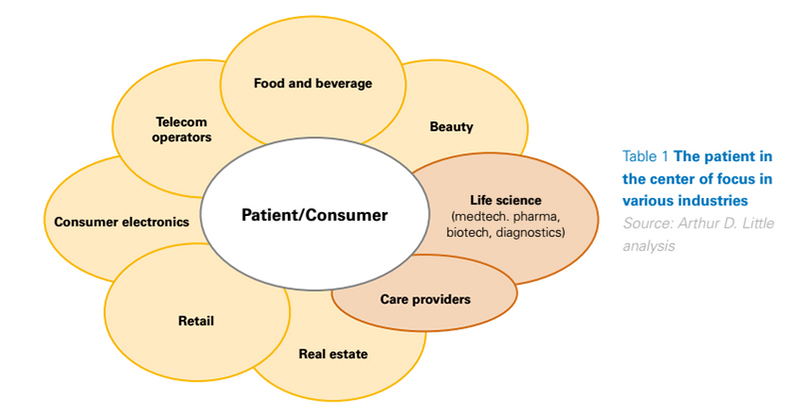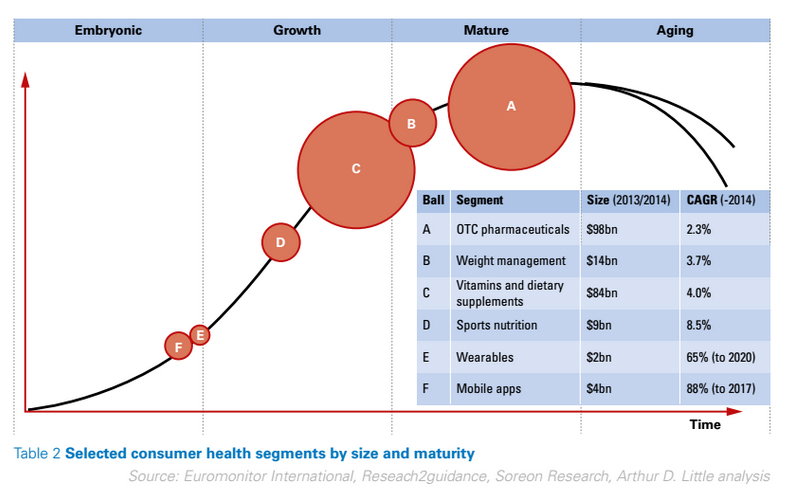Embracing the Consumer Health Opportunity
How new market entrants are changing the sector.

Healthcare is no longer a business sector solely for companies in traditional life sciences core industries such as pharmaceuticals, med tech and diagnostics. It is rapidly becoming an interdisciplinary arena that is of interest to businesses from many other industries, such as R&D-driven food-and-beverage companies, consumer electronics, telecom, housing/real estate and retail.
This is because of the increasing sophistication of consumers, combined with the drive towards healthier lifestyles, which is leading to the creation of new, cross-industry business opportunities. Innovative technologies that enable increased access to information and greater possibilities for knowledge sharing have led to health consciousness moving from a niche to a mainstream market.
Technological development and changing purchase and consumption patterns
Today’s technological landscape is different from how it was in the recent past. New generations of consumers use mobile technology as a natural extension of themselves. Consumers are adopting broadband: 34% of the global population now has access to it. Europe is embracing mobile devices: 38% of European consumers own smartphones or tablets. Online retail is growing by double-digit percentages annually. Looking further ahead, the Internet of Things (IoT) is extending connectivity to cars, houses and medical equipment, for example.
The future development of consumer healthcare
Consumer health is a broad definition, covering everything from a gym-goer aiming to stay healthy to a patient looking to manage a chronic disease. Consequently, it is composed of a number of business areas, ranging from the large and mature, such as over-the-counter (OTC) pharmaceutical sales, to expected fast-growth markets, such as wearables and mobile apps. The common denominator is that they are all centered on the patient/consumer.
As a consequence of technological development, both consumers and patients are better informed, have wider choice, and demand increased personalization. Today, patients have plenty of options on where to go for information, and once they reach the doctor’s office they already have their own hypotheses on potential diseases and disease management. Patients are also increasingly open to non-state-funded solutions and looking towards solutions outside of cost-pressured healthcare systems.
Opportunities offered
The successful business models of the future will be associated with giving a large population access to awareness and “prevention” solutions.
The actions required to reap the benefits of this development depend on a company’s existing capabilities, but it is clear that new business opportunities are available to both established healthcare players and new entrants. The qualities required to succeed are likely to be a combination of those possessed by the two. In order to capture consumers’ interests, players already in the market need new perspectives, whereas new entrants need to ensure health (care) knowledge and credibility.
The consumer health space is naturally more oriented towards screening and prevention, and capturing consumers before they become patients. The successful business models of the future will be associated with giving a large population access to awareness and “prevention” solutions. Innovation will clearly be a driving force here, in terms of both technology and the development of “consumer-friendly” business models.
New entrants
New players can leverage existing expertise from their original markets and use it for healthcare products and applications. Telecom operators, which are facing margin pressure in their core businesses, are looking towards connected devices, for example for remote patient monitoring, to be a strong revenue driver.
Retailers are also rapidly moving into the health-related services market. One development here is the introduction of health centers where retailers incorporate professional medical services into their offerings. This repositioning of stores is an efficient way of attracting health-conscious customers looking for a one-stop-shop where all their needs are met. There are also new types of businesses emerging. Companies such as LifeQ (see case study), which uses computational systems biology to provide consumers with actionable health information, are trying to fill gaps in existing solutions and thus enable a shift towards a patient-centric model.
Adjacent industries
For industries that border healthcare, such as food and beauty, consumer health represents a growth market as well as a way to create a positive brand image. Willingness to spend money on diet options perceived to be healthy is increasing enormously, and traditional food giants such as Nestlé are developing “health brands”. After recent food scandals it has become vital for the giants to prove that their food is indeed healthy. One way of doing so is by clearly linking the brand to a healthcare value proposition.
Existing healthcare players
The development of consumer health offers potential for healthcare players to make money outside of their traditional business models and customer groups. Health service providers such as Mayo Clinic (see case study) are using their health-related brand strength to expand into all types of health-related services and products aimed at both consumers and professionals. Just as it is possible for retail players to add healthcare capabilities to become health centers, it is also possible for professional health-service providers to dedicate space and time to consumer-driven business and achieve theme-oriented retail concepts. In Japan, “anti-aging clinics” are an attractive segment for younger doctors looking to broaden their medical offerings outside of public coverage.
The increased amount of information available to patients is not all positive. It also provides a huge challenge for healthcare providers as hypotheses are often developed from various sources and without clinical education.
Case Study 2: The Mayo Clinic
The Mayo Clinic is one of the world’s largest non-profit medical organizations, which has established a powerful brand reputation and strong brand loyalty among consumers worldwide.
Its success can be explained by the fact that Mayo is at the heart of a new healthcare ecosystem, providing an extended range of medical products and services to consumers and healthcare professionals.
In addition to medical treatments, these include the organization of multiple health programs, laboratory services for healthcare organizations and the provision of educational materials for patients and professionals. On its website, for instance, patients can find information on over 100 diseases, together with symptoms, possible causes, risk factors, and complications.
It also tells the patient how to prepare for an appointment (to-do lists, questions to ask, what to expect from your doctor, etc.), the tests available, information regarding treatment and drugs, as well as how to cope with the disease and advice for support. Even more importantly, Mayo has cultivated a spirit of service excellence, which is deeply embedded in the organization, emphasizing a patient-centric culture. Social media and mobile technology is an enabler of this culture, with the organization offering various apps.
For example, with the ‘Mayo Clinic Patient App’, patients are offered access to the latest news, publications and health information from Mayo Clinic. It also includes personal medical records and appointment schedules. Recent features include the availability of the patient’s radiology images and immediate access to lab results. In 2010, Mayo Clinic created the ‘Mayo Clinic Center for Social Media’ to regroup and coordinate its various social media initiatives and programs.
It believes individuals have the right and responsibility to control their own health, and that it has a responsibility to help patients use social media tools to get the best information, to connect with providers and each other, as well as to inspire healthy choices. Social media is at the forefront of the Clinic’s values and the leadership is actively involved. CEO John Noseworthy supports the Clinic’s online presence and even highlighted the critical role of it in the future of healthcare.
Social media will become a part of routine healthcare operations and consumers’ day-to-day lives and thus increasingly influence the choice of healthcare provider. A key element is patient engagement through social media: patients sharing outcomes and supporting each other, doctors discussing treatments, and hospitals acquiring new patients through Facebook.
The Clinic is also creative in discovering new applications for social media and is regularly introducing innovative ways of interacting and introducing patients to the professional they will be receiving their care from. As an example, YouTube is used to show videos of a surgeon performing surgery.
The increased amount of information available to patients is not all positive. It also provides a huge challenge for healthcare providers as hypotheses are often developed from various sources and without clinical education. This tends to drive costs for healthcare as patients demand expensive examinations and tests even if they are not relevant. Healthcare providers who can provide their patients with information in a consumer-friendly manner could gain control by providing constructive information that aligns patient expectations with the medical reality. Hospitals can further respond by transforming into client-centered organizations that are always connected with their patients, both before they enter the hospital and after they leave. A best-practice example is the Mayo Clinic, which proactively manages knowledge sharing and interaction with patients through online channels and social media.
Over the course of the last decade the consumer health industry has risen as an important force that is reshaping the future of health care, enabling an individual-centric model whereby consumers play a more central and informed role, alongside providers, in health care prevention, maintenance and ultimately, treatment. Players targeting the consumer health opportunity space need to anticipate what the world will look like a couple of years ahead, what kind of solutions will be offered to consumers and decide where to be present and build the required capabilities.
For those that succeed in this cross-dimensional opportunity space, the rewards are likely to be substantial.
About the Authors:
Nils Bohlin is a Partner in the Stockholm office of Arthur D. Little and leads the Global Healthcare Practice.
Maki Kurosawa is a Partner in Arthur D. Little’s Tokyo office and heads the Consumer and Healthcare Practice in Japan.
Dirk Luyten is a Partner in the Brussels office of Arthur D. Little and a member of the Global Strategy and Organization Practice.
John Brennan is a Managing Director in the Boston office and a member of the Healthcare Practice.
Rebecka Axelsson Wadman is a Manager in the Stockholm office of Arthur D. Little and a member of the Consumer and Healthcare Practice in Sweden.


